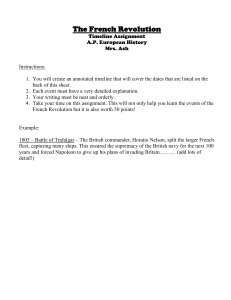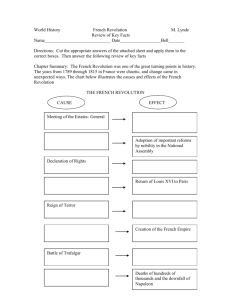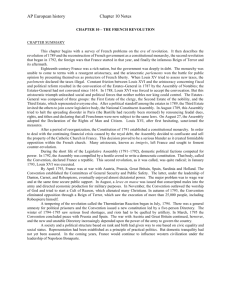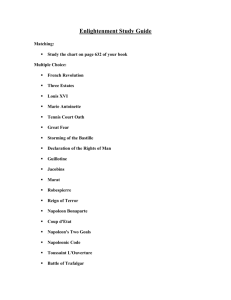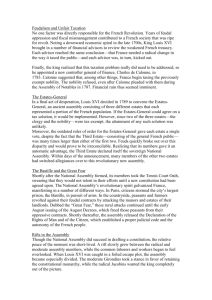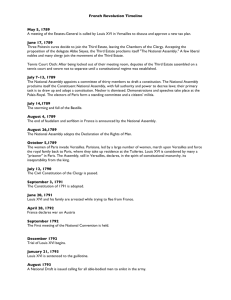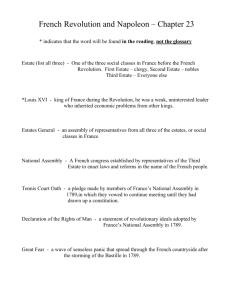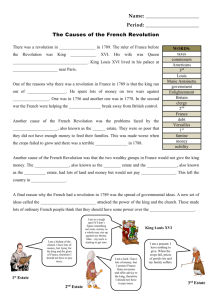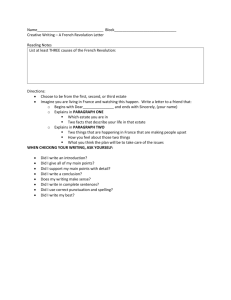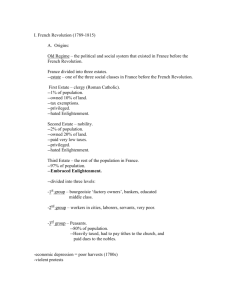The French Revolution Timeline May 5, 1789 Estates
advertisement
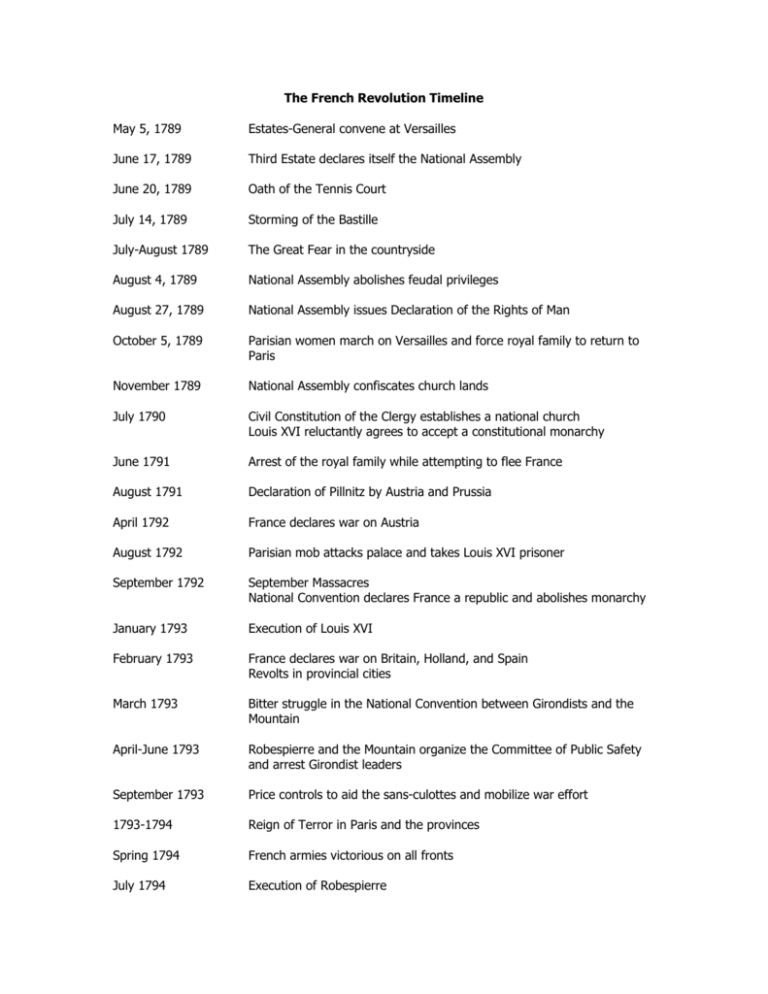
The French Revolution Timeline May 5, 1789 Estates-General convene at Versailles June 17, 1789 Third Estate declares itself the National Assembly June 20, 1789 Oath of the Tennis Court July 14, 1789 Storming of the Bastille July-August 1789 The Great Fear in the countryside August 4, 1789 National Assembly abolishes feudal privileges August 27, 1789 National Assembly issues Declaration of the Rights of Man October 5, 1789 Parisian women march on Versailles and force royal family to return to Paris November 1789 National Assembly confiscates church lands July 1790 Civil Constitution of the Clergy establishes a national church Louis XVI reluctantly agrees to accept a constitutional monarchy June 1791 Arrest of the royal family while attempting to flee France August 1791 Declaration of Pillnitz by Austria and Prussia April 1792 France declares war on Austria August 1792 Parisian mob attacks palace and takes Louis XVI prisoner September 1792 September Massacres National Convention declares France a republic and abolishes monarchy January 1793 Execution of Louis XVI February 1793 France declares war on Britain, Holland, and Spain Revolts in provincial cities March 1793 Bitter struggle in the National Convention between Girondists and the Mountain April-June 1793 Robespierre and the Mountain organize the Committee of Public Safety and arrest Girondist leaders September 1793 Price controls to aid the sans-culottes and mobilize war effort 1793-1794 Reign of Terror in Paris and the provinces Spring 1794 French armies victorious on all fronts July 1794 Execution of Robespierre Thermidorean Reaction begins 1795-1799 The Directory 1795 End of economic controls and suppression of the sans-culottes 1799 Napoleon defeats Austrian armies in Italy and returns triumphant to Paris 1798 Austria, Great Britain, and Russia form the Second Coalition against France 1799 Napoleon overthrows the Directory and seizes power The French Revolution The French Revolution is a complex phenomenon with several stages and several phases. Supporters see it as a necessary rebellion against tyranny and aristocratic privilege. Critics see it as the unleashing of mob feeling and rabble behavior destructive of order and stability. Its causes were many: Long range—state inefficiency buttressed by entrenched privilege. Opportunities for social mobility were negligible for the educated and wealthy bourgeoisie. They could not rise in the social scale or hold the highest state offices. Nobles held the highest offices in the church and in the parlements (law courts). They were exempt from taxation in the ancien régime. In short, they formed a closed and socially privileged caste. Short range—a government, financial crisis. The government was bankrupt. Fifty percent of its expenditure was used to pay interest on the growing debt, and less than 20 percent financed general maintenance of the state (25 percent maintained the military and 6 percent, the upkeep of Versailles). The First Phase In order to remedy the problem of debt, Louis XVI agrees to call the Estates-General, the national assembly, which had not convened since 1614. The summoning initiates the first act of the revolution, as each estate draws up its cahier de doléances, or list of grievances. The subsequent acts are outlined below. Act I: The nobility insist that Louis XVI call the Estates-General if he wishes to levy a taille, or land tax, on those who have been legally exempt from paying taxes. Members of the nobility are intending to reassert their political power, which was lost under Louis XIV, and are resurging under the recall of the parlements by Louis XVI. Thus the aristocracy has engineered the first act of the revolution. The Estates-General will convene as it did in 1614 with three separate estates, each having one vote. Act II: The Third Estate has twice as many representatives as those of the First Estate (the clergy) and the Second Estate (the nobility) combined. They chafe at the arrangement of separate estates with a single vote as an insult to the economic power they hold. On June 20, 1789, representatives of the Third Estate and some liberal nobles having declared themselves the National Assembly, move to a large indoor tennis court where they take the Tennis Court oath, swearing never to disband until they have written a new constitution for France. The bourgeoisie have thus engineered the second act, for the king capitulates and orders all representatives to sit in one assembly with one vote per person. In this assembly the bourgeoisie are on an equal social footing with the nobility. Act III: Unrest is high in Paris. Poor grain harvests and high bread prices increase agitation. Meanwhile, Louis XVI has dismissed some liberal ministers and has begun summoning a mercenary army to Versailles. The Parisian workers, known as sans-culottes, think it necessary to arm themselves for impending trouble. They storm the Bastille, a fortress where arms and gunpowder are kept. Panic ensues. The governor of the prison and ninety-eight people are killed. Louis XVI recalls his ministers and disperses the troops. The Parisian mob has engineered the third act. They have saved the National Assembly from being dismissed by the king. Act IV: In the summer of 1789, rumors spread that the aristocrats are hiring outlaws to harm the peasants. The rumors, known as the Great Fear, are unfounded. Nevertheless, the peasants burn manor houses and manorial records in a state of uncontrolled violence. Liberal-thinking aristocrats and members of the bourgeoisie meet secretly at Versailles on the night of August 4 to declare feudalism abolished in France. The peasants have engineered the fourth and final act of the first phase of the French Revolution. No longer will the peasants have to pay fees (banalités) to their lord for hunting, justice, or salt. Nor will they be obliged to work on the roads (corvées). As religious Catholics they become forces for conservatism and stability. The crowning act of the first phase of the revolution is the issuance of the Declaration of the Rights of Man and Citizen by the National Assembly on August 27, 1789. The Second Phase In the second phase of the French Revolution, women march to Versailles in protest over rising bread prices. A constitutional monarchy is established, but Louis XVI is opposed and tries to flee. He is captured and eventually guillotined when the Committee of Public Safety is established under Robespierre (1758-1794) during the third and radical phase of the revolution. The Legislative Assembly, dominated by the Jacobins, has declared war on Louis’s allies Austria and Prussia, hoping to save the revolution from conservatives who wish to restore the ancien régime. The assembly is replaced by a National Convention. It decrees a levee en masse to make the resources of the nation available to fight the war. And in the face of economic chaos, it establishes the law of the maximum, which fixes prices on bread and other essential items to curb inflation. The Third Phase In the third phase, Robespierre’s death at the hands of those who fear his extremism ushers in the period known as the Directory (1795-1799), a short- lived government dominated by corrupt leaders who ignore the economic problems facing the country and continue to wage war. Napoleon in Power In the final phase, in a November 1799 coup d’état, a young general, Napoleon Bonaparte (17691821) heads the troops that overthrow the Directory and establishes a new form of republic, the Consulate. Napoleon centralizes authority by setting up the machinery of government headed by a Council of State with himself as chief administrator. He rules as first consul, and then as emperor in 1804. He appoints prefects who administer local government along with the mayors, his appointees as well, and consolidates his power even further with tight censorship of press and news. How shall his rule be evaluated? Napoleon’s Domestic Policies To his credit, Napoleon undid to some extent the great tactical blunder of the Revolution—the establishment of a national church, with priests chosen by voters and the clergy required to take a loyalty oath to the new civil constitution. French Catholics had turned against the Revolution. The pope himself had condemned it. Napoleon and Pope Pius VII signed the Concordat (1801), which made Catholicism the “preferred religion” of France. Napoleon nominated the bishops, who were consecrated by the pope. The French leader recognized the social power of religion as a unifying force for his country. He also understood the importance of allegiance to the state and created a Legion of Honor to reward middle-class abilities. “It is with trinkets that mankind is governed,” he allegedly said. And by setting up lycées, elite secondary schools, and instituting primary schools, all of which were controlled by the University of France, another of his creations, Napoleon was able to direct the curriculum to ensure loyal citizens. And for his loyal citizens he maintained the principles of legal equality in the Code Napoleon, the codes of law that he drew up. The principles were brief and clear in the areas of civil, criminal, commercial, and family law, among others.
